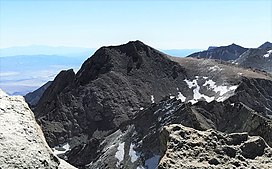Trojan Peak
| Trojan Peak | |
|---|---|
 Northwest aspect, from Mt. Tyndall | |
| Highest point | |
| Elevation | 13,947 ft (4,251 m)[1] |
| Prominence | 364 ft (111 m)[1] |
| Parent peak | Mount Barnard |
| Isolation | 0.84 mi (1.35 km)[1] |
| Listing | Sierra Peaks Section[2] |
| Coordinates | 36°38′32″N118°18′55″W/ 36.6423223°N 118.3152859°W[3] |
| Naming | |
| Etymology | USC Trojans |
| Geography | |
| Location | Inyo County,California, U.S. |
| Parent range | Sierra Nevada |
| Topo map | USGSMount Williamson |
| Geology | |
| Age of rock | Cretaceous |
| Mountain type | Fault block |
| Type of rock | granitic |
| Climbing | |
| First ascent | 1926 |
| Easiest route | Simple scrambleclass 2[2] |
Trojan Peakis a 13,947-foot-elevation (4,251-meter) mountain summit located along the crest of theSierra Nevadamountain range inInyo County,California.[3]It is situated in theJohn Muir Wilderness,on land managed byInyo National Forest.It is 15 miles (24 km) west-northwest of the community ofLone Pine,0.7 miles (1.1 km) southeast ofMount Versteeg,and one mile (1.6 km) south-southwest ofMount Williamson,the nearest higher neighbor. Trojan Peak is ranked as the 16th highest peak in California.[4]Topographic reliefis significant as it rises 1,427 feet (435 meters) above Lake Helen of Troy in approximately one-half mile.
History[edit]
Thefirst ascentof the summit was made June 26, 1926, byNorman Clyde,who is credited with 130 first ascents, most of which were in the Sierra Nevada.[5][6]The peak's name was proposed by Chester Versteeg of theSierra Club,and officially adopted by theUnited States Board on Geographic Namesin 1951.[3]As the first chairman the Sierra Club's Committee on Geographic Names, Versteeg was responsible for the naming of 250 geographical features in the Sierra Nevada, including Trojan Peak and Lake Helen of Troy, which he named for his alma mater,University of Southern California.[7]
Climate[edit]
According to theKöppen climate classificationsystem, Trojan Peak has analpine climate.[8]Mostweather frontsoriginate in thePacific Ocean,and travel east toward the Sierra Nevada mountains. As fronts approach, they are forced upward by the peaks, causing them to drop their moisture in the form of rain or snowfall onto the range (orographic lift). Precipitationrunofffrom this mountain drains east toOwens Valleyvia George Creek.

See also[edit]
References[edit]

- ^abc"Trojan Peak, California".Peakbagger.com.Retrieved2021-05-21.
- ^ab"Sierra Peaks Section List"(PDF).Angeles Chapter,Sierra Club.Retrieved2021-11-16.
- ^abc"Trojan Peak".Geographic Names Information System.United States Geological Survey,United States Department of the Interior.Retrieved2021-05-21.
- ^"California 13,500-foot Peaks".Peakbagger.com.Retrieved2021-11-16.
- ^Mendenhall, John D. and Ruth; Johnson, Arthur B.; Gigas, Braeme; Koster, Howard (1954)."A Climber's Guide to the High Sierra".Yosemite Online.Retrieved2021-11-16.
- ^"Norman Clyde - Mountaineer".OwensValleyHistory.com.Retrieved2021-11-16.
- ^Robinson, John W."History 101: The Life and Adventures of Chester Versteeg"(PDF).The Sierra Echo. pp. 14–17.Retrieved2021-11-16.
- ^Peel, M. C.; Finlayson, B. L.; McMahon, T. A. (2007). "Updated world map of the Köppen−Geiger climate classification".Hydrol. Earth Syst. Sci.11.ISSN1027-5606.
External links[edit]
- Weather forecast:Trojan Peak


